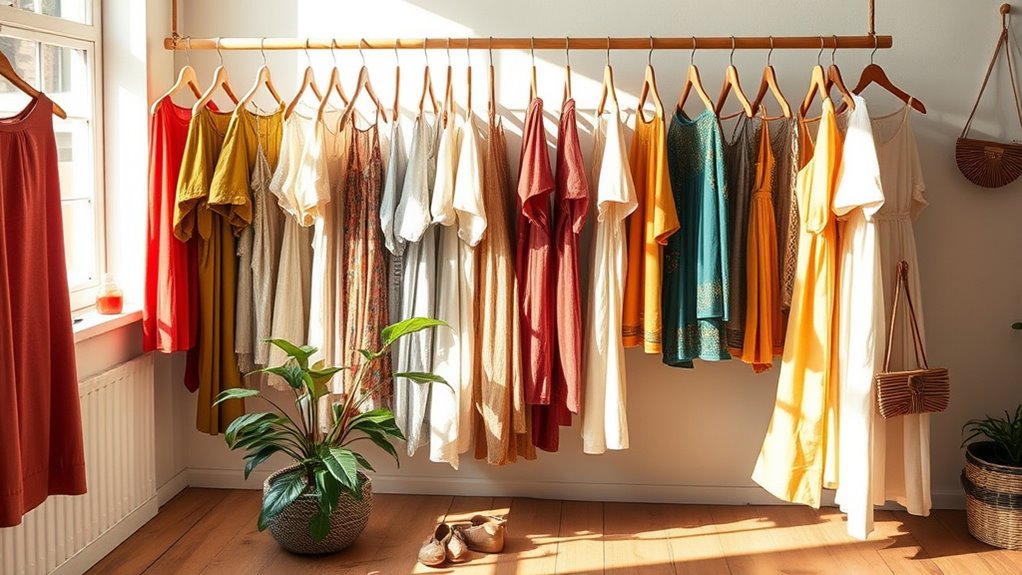To build an eco-friendly wardrobe, start by understanding sustainable fashion principles. Choose natural fibers like organic cotton and innovative materials such as Tencel. Focus on timeless pieces and guarantee you follow the 30 wears rule before making a purchase. Also, consider second-hand shopping and clothing swaps to reduce waste. Support brands that prioritize ethical labor practices and transparency in their supply chains. Discover more about sustainable practices and how they can transform your wardrobe.
Key Takeaways
- Conduct a wardrobe audit to identify items you wear often and declutter responsibly by donating or repurposing unused garments.
- Prioritize purchasing eco-friendly fabrics like organic cotton, hemp, and recycled materials to reduce environmental impact.
- Embrace timeless styles and neutral colors to create a versatile wardrobe that lasts beyond seasonal trends.
- Practice the 30 wears rule by ensuring new purchases are versatile and durable enough to be worn at least thirty times.
- Support ethical brands with transparent supply chains and certifications like GOTS and Fair Trade for responsible sourcing.
Understanding Sustainable Fashion
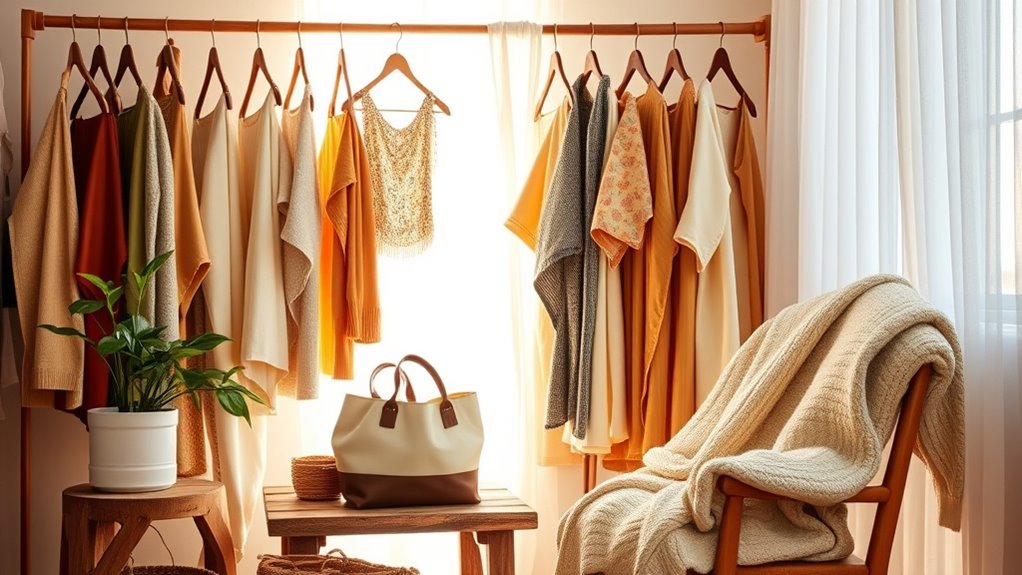
Sustainable fashion isn’t just a trend; it’s a necessary shift towards a more responsible way of producing and consuming clothing. It means creating and distributing apparel with a keen eye on environmental impact, social responsibility, and economic viability.
You’ve probably noticed that the fashion industry contributes heavily to pollution, waste, and resource depletion. Sustainable fashion aims to change that by promoting ethical labor practices and ensuring safe working conditions for everyone involved. It emphasizes environmentally friendly practices, which help to minimize waste and pollution associated with traditional fashion practices. Furthermore, adopting sustainable practices can reduce deforestation and its associated impacts, creating a more balanced ecosystem for future generations. Sustainable fashion also encourages performance upgrades in materials and production methods, enhancing durability and longevity. Technologies like solar power solutions can also be integrated into the production process, further reducing the environmental footprint of fashion brands.
It embraces practices like the circular economy, where recycling and upcycling become central to design. By understanding these core principles, you can make informed choices that benefit not just your wardrobe but also the planet and those who help make your clothes.
Choosing Eco-Friendly Fabrics

Choosing eco-friendly fabrics is essential for promoting sustainable fashion. Making conscious choices about the fabrics you wear plays a significant role in promoting sustainable fashion. Opt for natural fibers like organic cotton, hemp, and linen, which require fewer resources and chemicals. Bamboo is another great choice due to its fast growth and biodegradability. Additionally, organic cotton is grown without pesticides or synthetic fertilizers, further reducing environmental harm. Incorporating omega-3 content from plant-based sources like chia seeds into your diet can enhance your overall health, just as choosing sustainable fabrics can positively impact the environment. Utilizing high-quality equipment is crucial not only in sound recording but also in creating sustainable products that last longer. Beekeepers, for instance, often utilize sustainable practices to ensure the health of their hives and the surrounding ecosystem.
Explore semi-synthetic options like Tencel and ECOVERO™, both produced in eco-friendly processes. Utilizing recycled materials like polyester and nylon helps reduce waste while supporting sustainability. You can also consider innovative plant-based alternatives like Piñatex and Apple Leather, which offer cruelty-free options.
Finally, look for certifications such as GOTS and OEKO-TEX to guarantee your fabrics are ethically sourced and produced. Every fabric choice you make contributes to a healthier planet.
Building a Sustainable Wardrobe
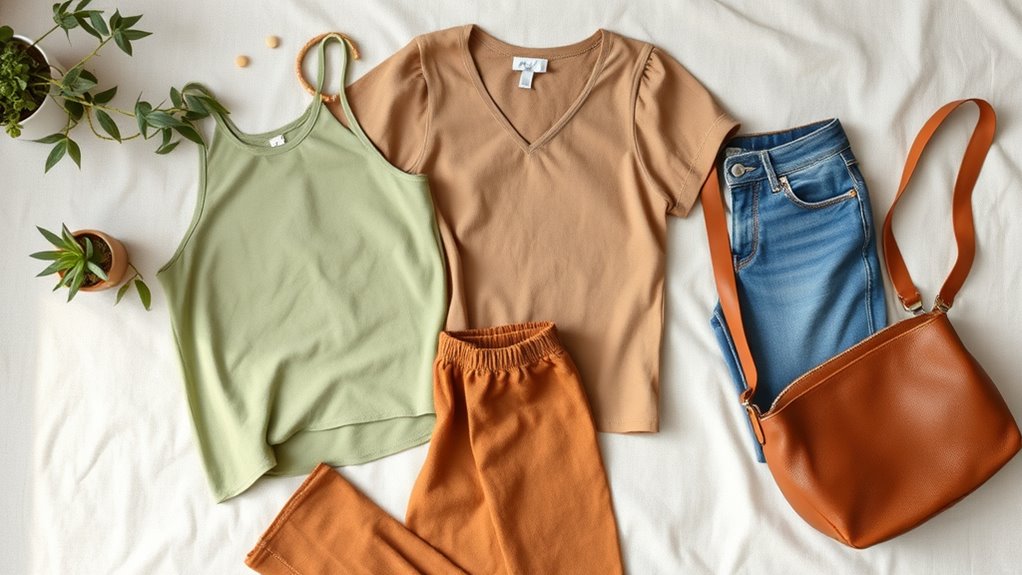
As you commence on the journey of building a sustainable wardrobe, it’s essential to start with an audit of your current collection. Identify the items you wear frequently to understand your personal style, and recognize those less-used pieces for potential donation or repurposing.
Declutter thoughtfully to reduce waste, and always consider the lifecycle of each garment. Using what you already own can significantly minimize your environmental impact, encouraging a more mindful approach to fashion. Additionally, incorporating natural materials like linen into your wardrobe can enhance sustainability by reducing dependency on synthetic fibers. For example, many sustainable fashion brands prioritize durable fabrics that are both eco-friendly and stylish, which can also include organic cotton for added benefits.
Next, prioritize timeless pieces that never go out of fashion. Invest in neutral colors and durable fabrics like cotton, wool, and linen.
Verify your garments fit well for longevity, and remember the 30 wears rule for new purchases. By focusing on quality over quantity, you’ll create a wardrobe that’s not only eco-friendly but also uniquely yours.
Supporting Ethical Brands

While exploring fashion choices, you might find that supporting ethical brands not only aligns with your values but also enhances your wardrobe.
Look for brands that prioritize transparency in their supply chains, like Everlane and Maggie Marilyn, which guarantee you know where materials come from. Check for certifications like B Corp and Fair Trade, which indicate a commitment to ethical practices.
Brands such as Christy Dawn and Patagonia use eco-friendly materials and sustainable production processes, providing quality over quantity. By choosing ethical brands, you contribute to fair labor practices, promote environmental conservation, and support local communities. Additionally, these brands often engage in community engagement to support local artisans and craftspeople, further enriching the fashion ecosystem. Choosing ethical brands can also lead to lower carbon footprints as sustainable practices help reduce environmental impact. Supporting these brands can foster a sense of community and encourage collaboration among designers and consumers. Furthermore, many ethical brands are inspired by renewable energy innovations in their production processes, leading to a more sustainable future for the fashion industry. Researching brand practices and using rating platforms can help you make informed decisions that reflect your commitment to sustainability.
Reducing Waste and Promoting Circularity

By embracing innovative practices, you can markedly reduce waste and promote circularity in the fashion industry. Consider zero-waste pattern making and seamless knit technology to maximize fabric use, minimizing production waste. Additionally, adopting made-to-measure programs helps ensure that every garment produced meets individual customer needs, thus further reducing overproduction. The use of organic materials can also significantly lessen the environmental impact of garment production. Furthermore, the implementation of circular economy practices can drive sustainability in fashion, ensuring resources are utilized efficiently. Rainwater capture techniques can also be creatively applied in the production process to reduce water waste.
You might also explore made-to-measure programs and 3D body scanning for tailored garments that fit perfectly, cutting down on returns and alterations. Additionally, upcycling and repurposing old garments extends the life of materials, while rental services and second-hand shopping lessen the demand for new clothing.
Incorporating recycled materials in your wardrobe not only conserves resources but also reduces CO2 emissions. Finally, adopting closed-loop production systems guarantees that materials are continuously cycled back into use, creating a sustainable fashion cycle that benefits everyone.
Economic and Social Benefits
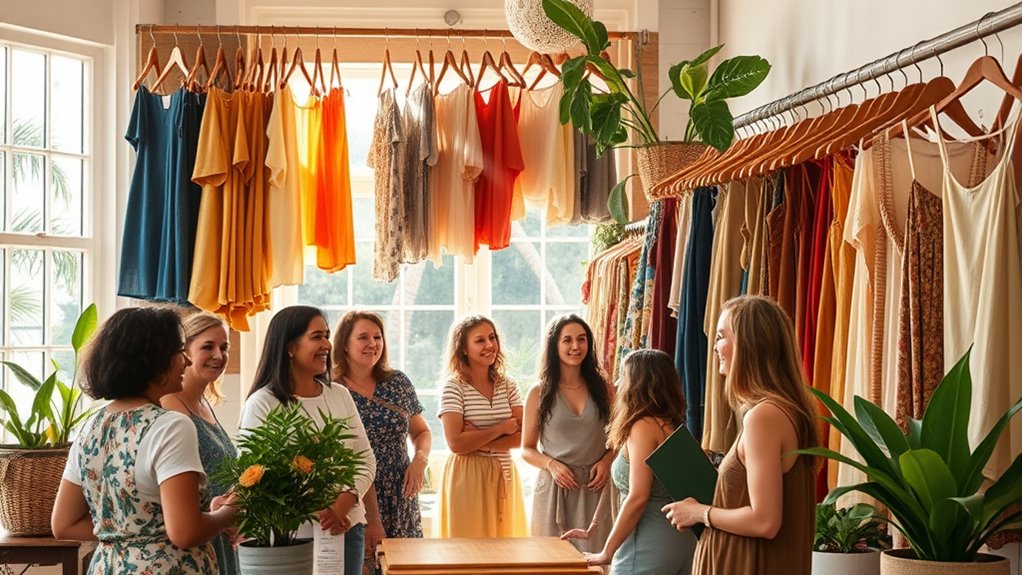
Sustainable fashion not only addresses environmental concerns but also offers significant economic and social benefits that can transform communities.
By supporting local businesses and suppliers, it boosts economic stability in regions reliant on the garment industry. The demand for sustainable products creates job opportunities, enhancing local economies and empowering artisans. Prioritizing local materials helps farmers and suppliers thrive, while high-quality sustainable clothing saves you money in the long run. Supporting fair wages contributes to improving living standards for artisans and workers, ensuring they can sustain their craft and livelihoods. Additionally, sustainable practices reflect a unique spiritual connection to the land, akin to how the Hopi Tribe embodies their relationship with the Earth. Furthermore, the promotion of fair labor practices in sustainable fashion can lead to healthier communities and improved living conditions. Moreover, sustainable fashion emphasizes ethical sourcing by ensuring that materials are obtained responsibly, further supporting the welfare of the environment and local economies.
Socially, sustainable fashion champions fair labor practices, ensuring workers receive fair wages and safe working conditions. It promotes gender equality and improves access to education and healthcare in local communities.
Ultimately, sustainable fashion fosters community development and celebrates cultural heritage, enriching lives through ethical and responsible practices.
Tips for Maintaining Your Eco-Friendly Wardrobe

Caring for your eco-friendly wardrobe not only prolongs the life of your garments but also reinforces your commitment to sustainable fashion.
Start by washing less frequently and only in cold water, using eco-friendly detergents for a gentler clean. Aim for full loads and consider spot cleaning to save resources. Always follow care labels, handle delicate fabrics with care, and mend small tears to extend garment life. Additionally, proper clothing care significantly reduces the need for replacements, lowering resource demand and conserving vital resources such as energy and water. Regularly maintaining your wardrobe can also create a sense of accomplishment as you take control of your environment and contribute to reducing waste through mindful consumption.
Store clothes in breathable natural materials, avoiding plastic to prevent moisture buildup. Line drying is kinder to fabrics and the environment.
Embrace quality over quantity, shop secondhand, and consider clothing swaps to refresh your collection. Regular maintenance and seasonal assessments will keep your wardrobe sustainable and clutter-free.
Resources for Sustainable Fashion Advocacy
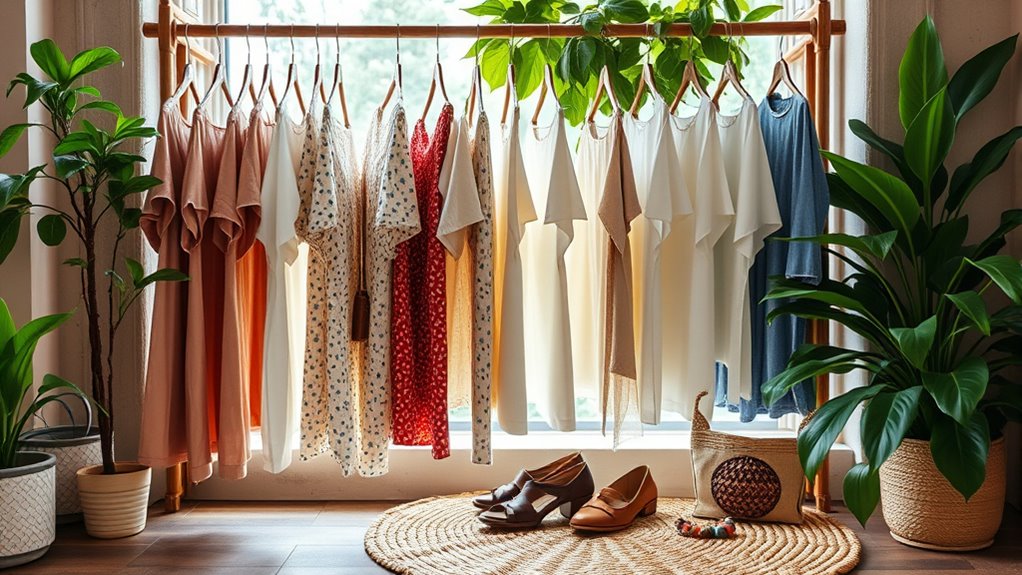
As you explore the world of sustainable fashion advocacy, you’ll find a wealth of resources designed to empower and educate. Documentaries like *The True Cost* and *Fashion Reimagined* reveal the hidden impacts of the fashion industry. Organizations such as Fashion Revolution and Remake work tirelessly to promote transparency and fair labor practices. You can immerse yourself in insightful books like *The Conscious Closet* and *Fashionopolis* for deeper understanding. Additionally, engaging with sustainable fashion brands can provide practical options for building an eco-friendly wardrobe. Online platforms like Good On You and Project Cece help you discover ethical brands, while secondhand shopping sites like ThredUp offer sustainable options. Engage with educational initiatives from Fashion Revolution or the Union of Concerned Researchers in Fashion to stay informed and active in the movement for change.
Frequently Asked Questions
How Can I Identify Sustainable Fashion Brands?
To identify sustainable fashion brands, start by researching materials used in their products. Look for organic cotton, recycled fabrics, or Tencel.
Check if the brand adheres to fair labor standards and has certifications like Fair Trade.
Assess their environmental impact by evaluating their production methods and packaging.
Finally, verify brand authenticity through clear labeling and sustainability reports.
Doing this will help you make informed choices and support responsible fashion.
What Are the Benefits of Secondhand Shopping?
Imagine walking into a treasure trove, where each item tells a story. That’s the beauty of secondhand shopping!
You’re not just saving money; you’re reducing waste and conserving valuable resources. By choosing pre-loved clothing, you’re cutting down on landfill contributions and lowering your carbon footprint.
Plus, you’re supporting local charities and embracing a more sustainable lifestyle. Each unique find helps shift the focus from fast fashion to a world of reuse and creativity.
How Do I Properly Care for Eco-Friendly Fabrics?
To properly care for eco-friendly fabrics, wash them in cold water to save energy and prevent fading.
Use biodegradable detergents for a gentler clean.
Avoid overloading the machine, and opt for gentle cycles to extend their lifespan.
Air drying is best, but if you use a dryer, stick to low heat settings.
Store your clothes in cool, dry places, and remember to repair any damages to keep them looking great longer.
Are There Eco-Friendly Options for Fast Fashion Items?
While the allure of fast fashion can be tempting, there are greener alternatives that won’t compromise your style.
You can find brands incorporating eco-friendly materials, like recycled fabrics or organic cotton, into their collections. Look for labels that prioritize sustainability and ethical practices.
Shopping at secondhand stores or online marketplaces can also provide unique finds while reducing waste.
Embracing these options lets you enjoy fashion responsibly without sacrificing your values.
How Can I Recycle Old Clothes Responsibly?
To recycle old clothes responsibly, start by using local textile recycling bins for items that can’t be donated.
Consider programs like For Days, which take back worn items for recycling. You can also explore partnerships with brands like Subset for specific garments.
If you’re feeling creative, try upcycling clothes into new items.
Participating in community clothing swaps or events helps you exchange unwanted items sustainably while keeping textiles out of landfills.
Conclusion
In crafting your eco-friendly wardrobe, remember that every choice you make echoes the call of the Earth, much like Thoreau’s pursuit of simplicity. By opting for sustainable fabrics and supporting ethical brands, you’re not just dressing yourself; you’re participating in a movement that champions both people and the planet. Embrace this journey, reduce waste, and wear your values with pride. Together, you can shape a more sustainable future, one outfit at a time.
